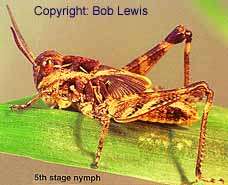Nymph description 6 of 15

Distribution

Nymph Description: Colour green to brown. From the side the thorax is raised and constricted on top and is higher than the head. Head is larger than the thorax in early stages and even later is about equal. There is a prominent dark stripe from the antennae, across the eye, to the back of the head at a 45 degree angle. From above, a lighter stripe runs along the entire body. Rear femur with strong bands in the early stages, less so later when the body becomes more generally mottled.
Confusion with Australian plague locust: General appearance only. Oedaleus does not have a complete 'X' mark on top of the thorax. The two bands across the rear femur of plague locust nymphs becomes more pronounced as they get older while the oblique angled bands in Oedaleus usually fade out. The Oedaleus eye from the side is an oblong at a 45 degree angle from the antennae, while the plague locust eye is an oblong placed vertically. Plague locust nymphs do not have the pronounced stripe across the side of the head (compare photo with Australian plague locust nymph).
Unique features: The combination of the face stripe, large head, light stripe along the top of the thorax distinguish them from plague locust and all other species. They can look similar to Gastrimargus in the early nymphal stages because of the raised thorax.
Further information on this species: Description of adult
